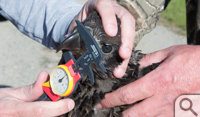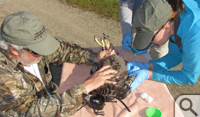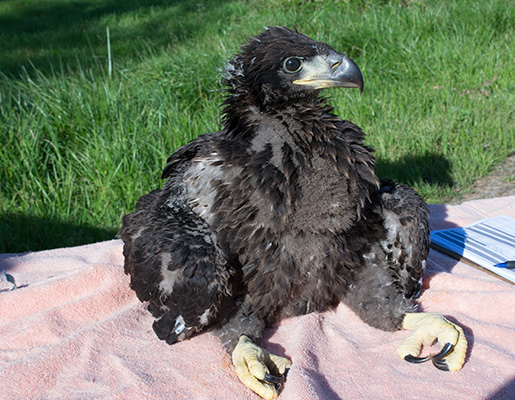Leaving the nest
The Center for Conservation Biology gives a young eaglet his first checkup
Shane Lawler was taking care of business in a loblolly pine, 90 feet above Gospel Spreading Farm, unfazed by the agitated bald eagles spiraling around his head.
“All right!” he yelled to Bryan Watts, waiting at the base of the tree. “I’ve got one bird in a bag.”
The bird in the bag was a five-week-old male eagle chick, the offspring of the very pair that was demonstrating bald-eagle conniptions. Lawler, an aerial technician for the Center for Conservation Biology, lowered the bagged bird on a rope to Center Director Bryan Watts.
Lawler, like Watts, wore protective headgear, but the eagles didn’t swoop in on him, keeping a reasonable distance even as their son was lifted from the nest and bagged.
“Different birds take this different ways,” Watts said, as he carried the bagged chick through the woods. “Eagles are OK with it, mostly. Ospreys are OK. Peregrines will come at you, though.”
A National Park Service study
The chick in the bag is a participant in a study funded by the U.S. Department of the Interior’s National Park Service. The Center for Conservation Biology is taking blood from eagle chicks like the young male at Gospel Spreading Farm, to check for presence of contaminants such as heavy metals, organochlorines and other industrial pollutants. The National Park Service wants to know how the reproductive rate of eagles on parks land compares with other eagles in the Chesapeake watershed.
Watts takes the bag to a working table set up on a dirt road just a few yards away from the nest tree, where Bart Paxton and Marie Pitts are waiting. Lawler will stay up in the tree, waiting for the return of the chick. The chick will be gone from nest for such a short period of time that it’s not worth it to climb down the tree, then back up.
“It’s nice up there,” Watts said. “I used to take my phone up there, make a couple calls. Maybe have a little nap.”
The bird submits to handling without objection. Watts said eagle chicks aren’t always so docile.
“This one’s a little younger than the ones we usually work with,” he said. “And he’s a male. Females can be a little more aggressive. The males tend to be a little more laid back.”
First thing: banding
First on the workup agenda is banding.
“We have the two bands on. The one is a USGS [U.S. Geological Survey] band,” Watts said, picking up a pop rivet tool. “Eagles are sort of special in that they take riveted bands because they have a history of taking the other band types off.”

The second band is a purple field-readable, alphanumeric band. Watts said that the bands can be read in the field through spotting scopes and telephoto lenses. “We get a lot of success from photographers re-sighting our birds, particularly in the lower Tidewater,” he said, adding that the photographers perform a valuable citizen-scientist role, sending in reports and photos which help the CCB track movements of the eagles.
Once the bands are on, the team takes morphometric measurements. Using calipers, Watts measures the hallux, the eagle’s thumb talon, then the tarsus, or ankle. Then the team moves on to the bill, taking several measurements.
Paxton, a CCB research biologist, keeps the bird calm and supported, manipulating the eagle while Watts takes measurements and calls them out as Pitts, the CCB’s data administrator, records each value. Watts puts down his calibers and picks up a carpenter’s rule to measure the wing and tail.
“The tail is one of the last things to grow out,” Watts explains, “It’s not even completely grown when they fledge.”
The eagle yields up a couple small feathers, samples for the sake of science —then Paxton puts a hood on the bird for the blood draw. The hood makes the already laid-back eagle even calmer. The bird slowly deflates, slumping over in Paxton’s grasp. Collapsed on the table, the masked and hooded eaglet looks like a defeated Mexican luchador wrestler.
 Pitts serves as phlebotomist, with Paxton and Watts holding the eagle steady and smoothing wing feathers back to give her access to the bird’s brachial vein. Three samples are taken. The sample vials contain an anticoagulant/preservative.
Pitts serves as phlebotomist, with Paxton and Watts holding the eagle steady and smoothing wing feathers back to give her access to the bird’s brachial vein. Three samples are taken. The sample vials contain an anticoagulant/preservative.
One vial, with a green cap, will be sent to Rob Hale, professor of marine science at William & Mary’s Virginia Institute of Marine Science, for a study of organic contaminants. A second, tan-capped sample goes to a graduate student at West Virginia University doing work on eagles. The purple cap goes to a lab in Wisconsin for a study of metals.
Back up the loblolly and home
Measured and sampled, the five-week-old chick is dehooded and rebagged for trip home. He goes back up the loblolly tree where Lawler is ready to return him to the nest and his anxious parents, none the worse for wear.
The CCB sampling team packs up for the short trip to Jamestown Island, where they have their work cut out for them. Five pairs of eagles are nesting on Jamestown Island this year. ![]()
The Center for Conservation Biology is a joint program of Virginia Commonwealth University and William & Mary.
















